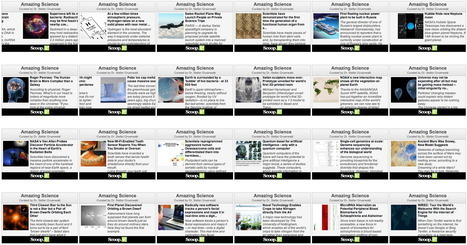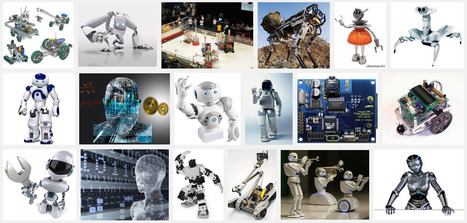 Your new post is loading...
Your ultimate online portal to the future as well as looking up the past. Reporting on what's new and what's next in technology, science, gadgets, astronomy, physics, math, green tech and much more. We are aggregating science news from over 1,600 international news sources and select the best science news every day, 7 days a week, 24 hours per day. A ranking algorithm preselects the postings. Dubious non-peer reviewed science is filtered out. Amazing Science is the ultimate source to stay on top of the ever changing disciplines of science and get have a scientific resource to your disposal that is unprecedented.
Astronomy is one of the oldest natural sciences and studies celestial objects (such as moons, planets, stars, nebulae, and galaxies), the physics, chemistry, mathematics, and evolution of such objects, and phenomena that originate outside the atmosphere of Earth, including supernovae explosions, gamma ray bursts, and cosmic background radiation. Theoretical astronomy is oriented towards the development of computer or analytical models to describe celestrial phenomena. A related but distinct subject, cosmology, is concerned with studying the universe as a whole.Shine on the web
Technology (from Greek "techne", meaning "art, skill, cunning of hand" and "logia", meaning "study") is the making, modification, usage, and knowledge of tools, machines, techniques, crafts, systems, and methods of organization, in order to solve a problem, improve a preexisting solution to a problem, achieve a goal, handle an applied input/output relation or perform a specific function. It can also refer to the collection of such tools, including machinery, modifications, arrangements and procedures. Examples include construction technology, medical technology, and information technology.
Robotics is the branch of technology that deals with the design, construction, operation, and application of robots, as well as computer systems for their control, sensory feedback, and information processing. These technologies deal with automated machines that can take the place of humans in dangerous environments or manufacturing processes, or resemble humans in appearance, behavior, and/or cognition. Today, robotics is a rapidly growing field, as technological advances continue, research, design, and building new robots, and any of today's robots are inspired by nature.
Photonics as a field began with the invention of the laser in 1960. Photonics includes the generation, emission, transmission, modulation, signal processing, switching, amplification, and detection/sensing of light. Photonics covers all technical applications of light over the whole spectrum from ultraviolet over the visible to the near-, mid- and far-infrared. Most applications, however, are in the range of the visible and near infrared light. The term photonics developed as an outgrowth of the first practical semiconductor light emitters invented in the early 1960s and optical fibers developed in the 1970s.
Paleontology is the scientific study of prehistoric life and includes the study of fossils to determine organisms' evolution and interactions with each other and their environments. Paleontology lies on the border between biology and geology, and shares with archaeology a border that is difficult to define. It now uses techniques drawn from a wide range of sciences, including biochemistry, mathematics and engineering. Use of all these techniques has enabled paleontologists to discover much of the evolutionary history of life, almost all the way back to when Earth became capable of supporting life, about 3,800 million years ago.
Nanotechnology includes fields of science as diverse as surface science, organic chemistry, molecular biology, semiconductor physics, microfabrication, and others. The associated research and applications are equally diverse, ranging from extensions of conventional device physics to completely new approaches based upon molecular self-assembly, from developing new materials with dimensions on the nanoscale to direct control of matter on the atomic scale. Nanotechnology may be able to create many new materials and devices with a vast range of applications, such as in medicine, electronics, and biomaterials.
Medicine is the applied science or practice of the diagnosis, treatment, and prevention of disease. It encompasses a variety of health care practices evolved to maintain and restore health by the prevention and treatment of illness in human beings. Contemporary medicine applies health science, biomedical research, and medical technology to diagnose and treat injury and disease, typically through medication or surgery, but also through therapies as diverse as psychotherapy, external splints & traction, prostheses, biologics, ionizing radiation and others.
Materials science, also known as materials engineering, is an interdisciplinary field applying the properties of matter to various areas of science and engineering. This relatively new scientific field investigates the relationship between the structure of materials at atomic or molecular scales and their macroscopic properties. It incorporates elements of applied physics and chemistry. With significant media attention focused on nanoscience and nanotechnology in recent years, materials science is becoming more widely known as a specific and unique field of science and engineering.
GeoSciences (Earth Sciences) is an all-embracing term for the sciences related to the planet Earth. It is arguably a special case in planetary science, the Earth being the only known life-bearing planet. The formal discipline of Earth sciences may include the study of the atmosphere, hydrosphere, oceans and biosphere, as well as the solid earth. Typically, Earth scientists will use tools from physics, chemistry, biology, chronology, and mathematics to build a quantitative understanding of how the Earth system works, and how it evolved to its current state.
Genetics concerns the process of trait inheritance from parents to offspring, including the molecular structure and function of genes, gene behavior in the context of a cell or organism (e.g. dominance and epigenetics), gene distribution, and variation and change in populations such as through Genome-Wide Association Studies (GWAS). Given that genes are universal to living organisms, genetics can be applied to the study of all living systems; including bacteria, plants, animals, and humans. Modern genetics seeks to understand this process which began with the work of Gregor Mendel.
Evolution is the change in the inherited characteristics of biological populations over successive generations. Evolutionary processes give rise to diversity at every level of biological organisation, including species, individual organisms and molecules such as DNA and proteins.All life on Earth is descended from a last universal ancestor that lived approximately 3.8 billion years ago. Repeated speciation and the divergence of life can be inferred from shared sets of biochemical and morphological traits, or by shared DNA sequences.
Education in Science is a collection of resources for learners. Resources include videos and interactives that help scientific learners find out about the different fields of science and make connections to what they are learning in school, college or university.
Lessons are inquiry based and encourage exploration in life science, physical science, earth science and technology/innovation. We are at a point where almost everyone has a computer at home, each of them hooked up to enormous libraries where anyone can ask any question and be given answers.
|
Over 13,700 postings. Your ultimate online portal to the future as well as looking up the past. Reporting on what's new and what's next in Machine Learning and Artificial Intelligence.
Astronomy is one of the oldest natural sciences and studies celestial objects (such as moons, planets, stars, nebulae, and galaxies), the physics, chemistry, mathematics, and evolution of such objects, and phenomena that originate outside the atmosphere of Earth, including supernovae explosions, gamma ray bursts, and cosmic background radiation. Theoretical astronomy is oriented towards the development of computer or analytical models to describe celestrial phenomena. A related but distinct subject, cosmology, is concerned with studying the universe as a whole.Shine on the web
Science (from Latin "scientia", meaning "knowledge") is a systematic enterprise that builds and organizes knowledge in the form of testable explanations and predictions about the universe. A practitioner of science is known as a scientist. Scientific fields are commonly divided into two major groups: natural sciences, which study natural phenomena (including biological life), and social sciences, which study human behavior and societies. Mathematics, which is classified as a formal science, has both similarities and differences with the empirical sciences (the natural and social sciences).
Physics is the natural science that involves the study of matter and its motion through space and time, along with related concepts such as energy and force. More broadly, it is the general analysis of nature, conducted in order to understand how the universe behaves. Physics is one of the oldest academic disciplines, perhaps the oldest through its inclusion of astronomy. Over the last two millennia, physics was a part of natural philosophy along with chemistry, certain branches of mathematics, and biology, but during the Scientific Revolution in the 17th century, the natural sciences emerged as unique research programs in their own right.
Photography (derived from the Greek word "photos" for "light" and "graphos" for "drawing") is the art, science, and practice of creating durable images by recording light or other electromagnetic radiation, either chemically by means of a light-sensitive material such as photographic film, or electronically by means of an image sensor. Typically, a lens is used to focus the light reflected or emitted from objects into a real image on the light-sensitive surface inside a camera during a timed exposure. Photography has many uses for business, science, manufacturing, art, recreational purposes, and mass communication.
Neuroscience is the scientific study of the nervous system and has traditionally been a branch of biology. The scope of neuroscience has recently broadened to include approaches to study the molecular, cellular, developmental, structural, functional, evolutionary, computational, and medical aspects of the nervous system. The techniques used by neuroscientists have also expanded enormously, from molecular and cellular studies of individual nerve cells to imaging of sensory and motor tasks in the brain. Recent theoretical advances in neuroscience have also been aided by the study of neural networks.
Microscopy is the technical field of using microscopes to view samples and objects that cannot be seen with the unaided naked eye. There are three branches of microscopy: optical, electron, and scanning probe microscopy. Optical and electron microscopy involve the diffraction, reflection, or refraction of electromagnetic radiation/electron beams interacting with the specimen, and the subsequent collection of this scattered radiation or another signal in order to create an image. The development of microscopy revolutionized biology and remains an essential technique in the life and physical sciences.
Mathematics is the abstract study of topics such as quantity/numbers, structure, space, and change. Mathematicians seek out patterns and formulate new conjectures and resolve the truth or falsity of conjectures by mathematical proof. When mathematical structures are good models of real phenomena, then mathematical reasoning can provide insight or predictions about nature. Through the use of abstraction and logic, mathematics developed from counting, calculation, measurement, and the systematic study of the shapes and motions of physical objects. Mathematics has been a human activity for as far back as written records exist.
Green energy is the sustainable provision of energy that meets the needs of the present without compromising the ability of future generations to meet their needs. Green energy includes natural energetic processes that can be harnessed with little pollution. Anaerobic digestion, geothermal power, wind power, small-scale hydropower, solar energy, biomass power, tidal power, wave power, and some forms of nuclear power which are able to "burn" nuclear waste through nuclear transmutation and therefore belong in the "Green Energy" category.
Genomics is a discipline within genetics that applies recombinant DNA, Next generation DNA sequencing methods, and bioinformatics to sequence, assemble, and analyze the function and structure of genomes - the complete set of DNA within a single cell of an organism). The field includes efforts to determine the entire DNA sequence of organisms and studies of intragenomic phenomena such as heterosis, epistasis, pleiotropy and other interactions between loci and alleles within the genome.
The future might hold a technological singularity and the emergence of superintelligence through technological means. Proponents of the singularity typically postulate an intelligence explosion, where superintelligences design successive generations of increasingly powerful minds, that might occur very quickly and might not stop until the agent's cognitive abilities greatly surpass that of any human. Ray Kurzweil predicts the singularity to occur around 2045 whereas artificial intelligence predictions by experts found a wide range of dates, with a median value of 2040.
Environmental science is a multidisciplinary academic field that integrates physical and biological sciences, including but not limited to ecology, physics, chemistry, biology, soil science, geology, atmospheric science and geography. Related areas of study include environmental studies and environmental engineering. Environmental studies incorporates more of the social sciences for understanding human relationships, perceptions and policies towards the environment. Environmental engineering focuses on design and technology for improving environmental quality in every aspect.
|
 Your new post is loading...
Your new post is loading...





































